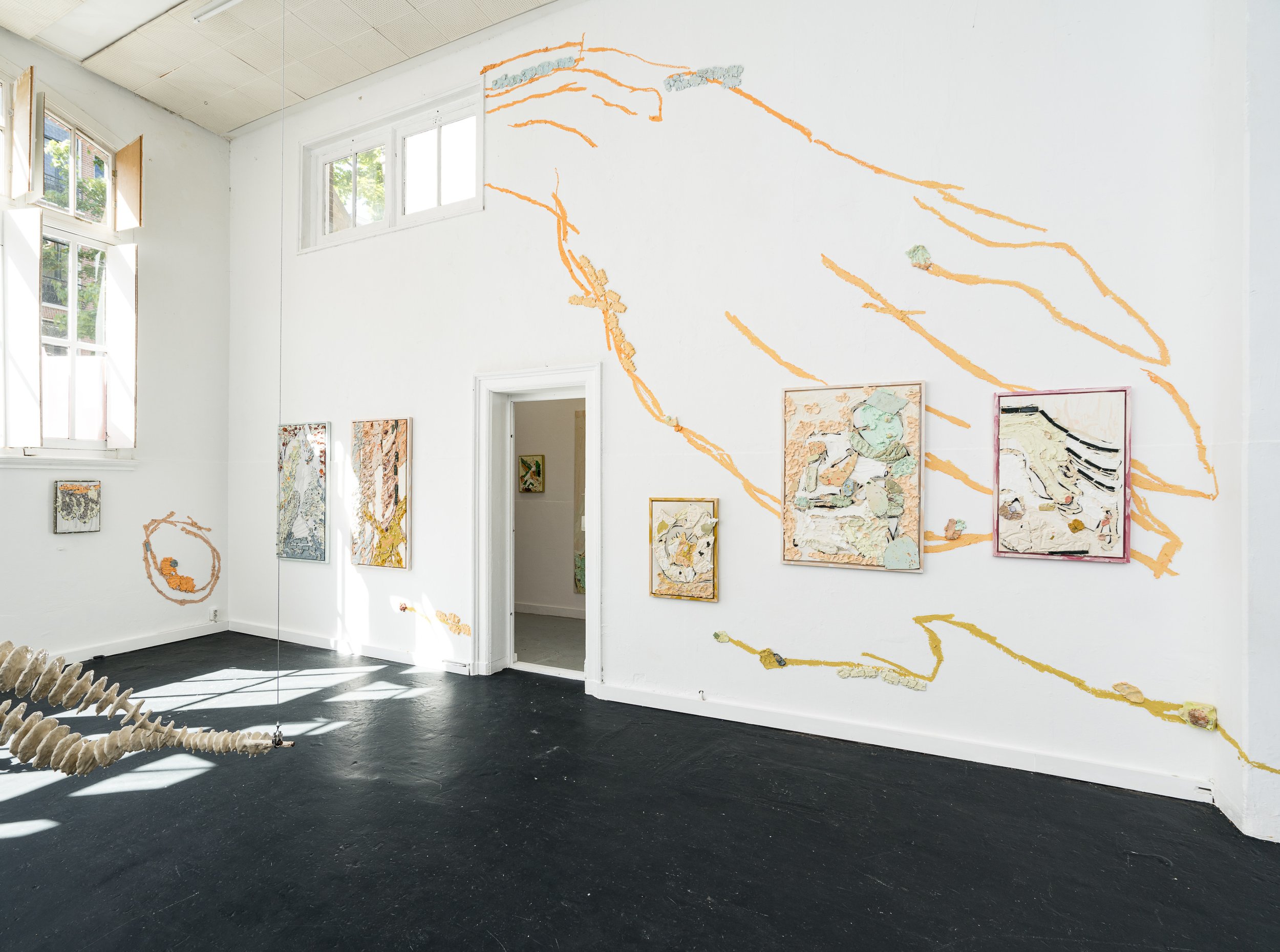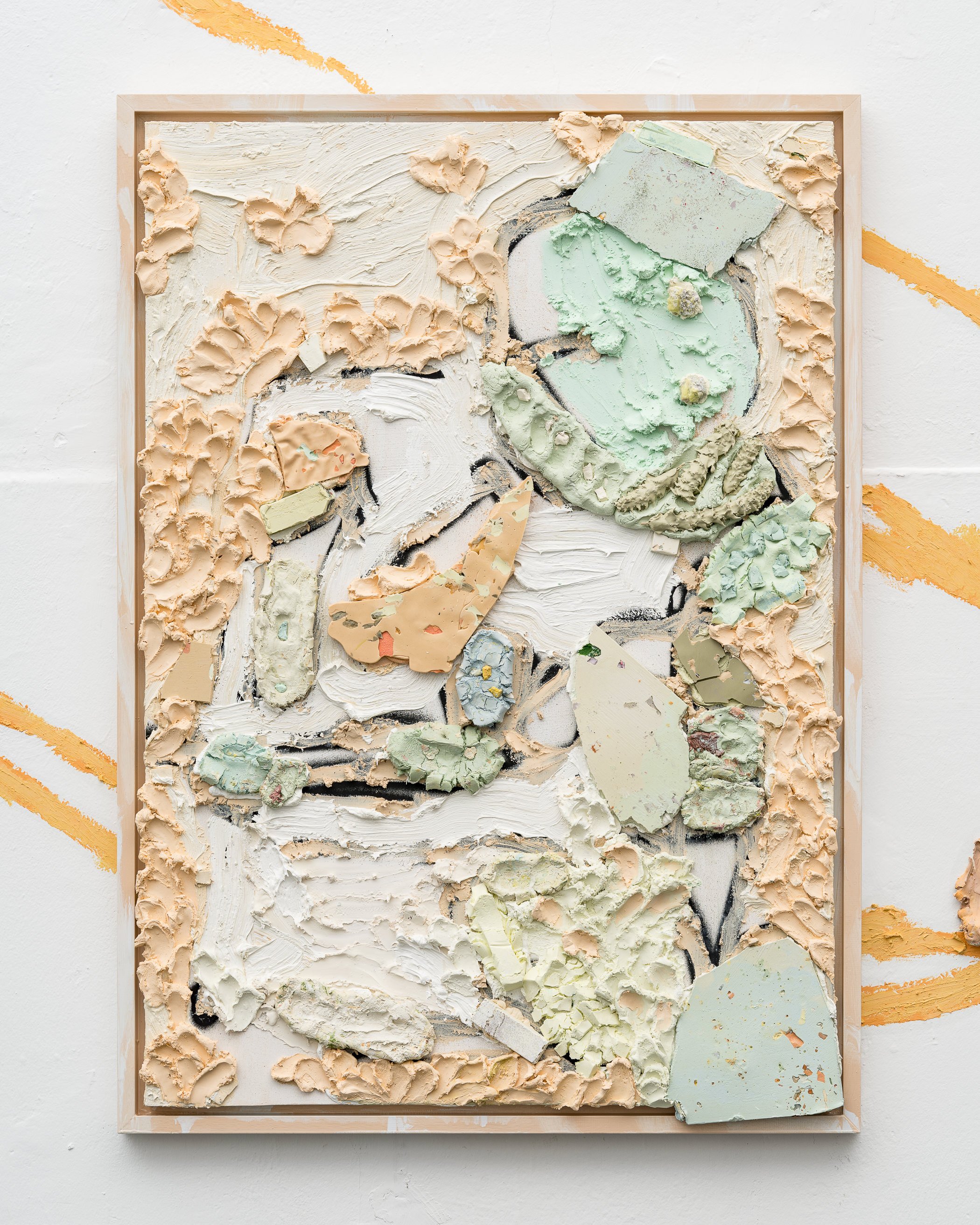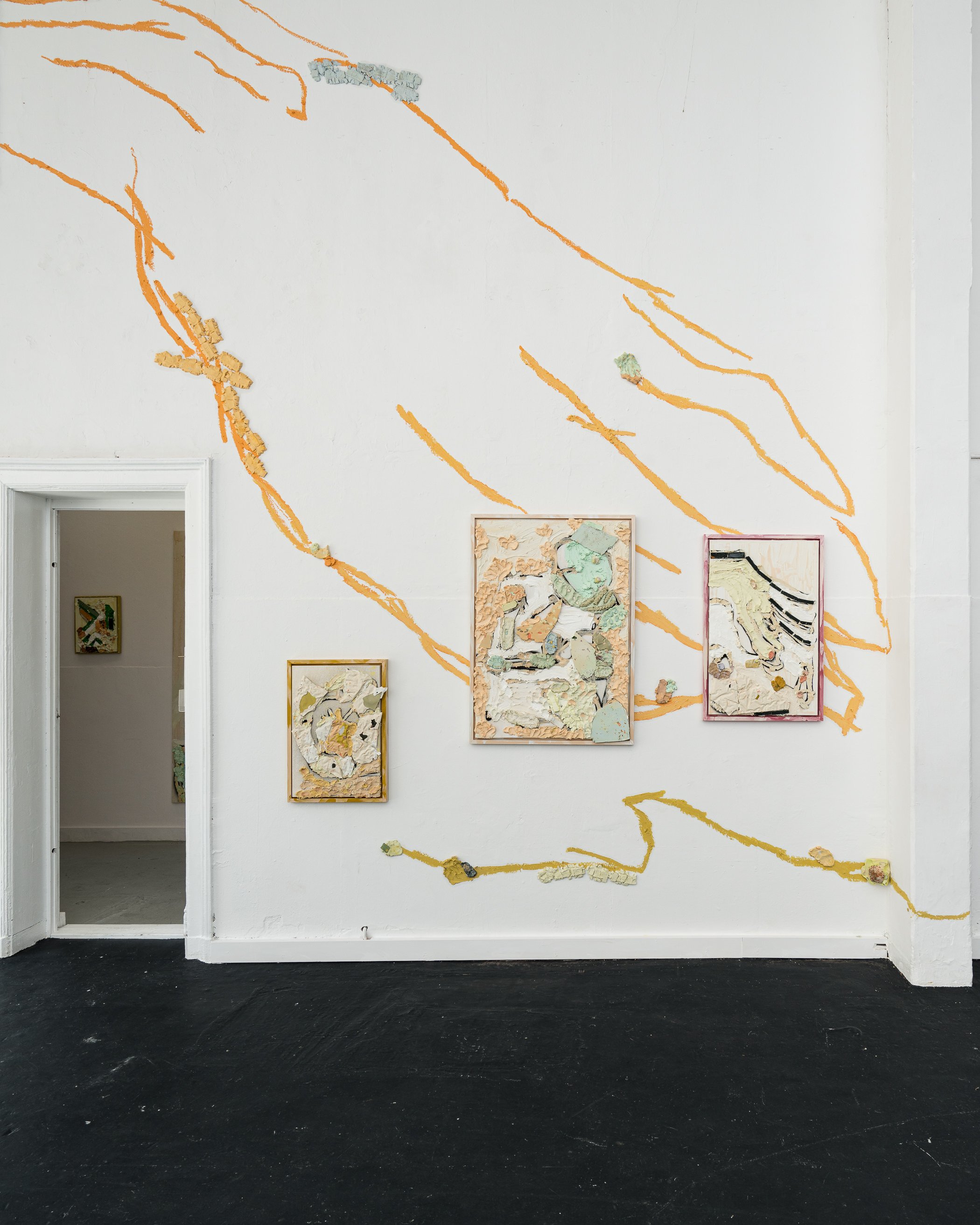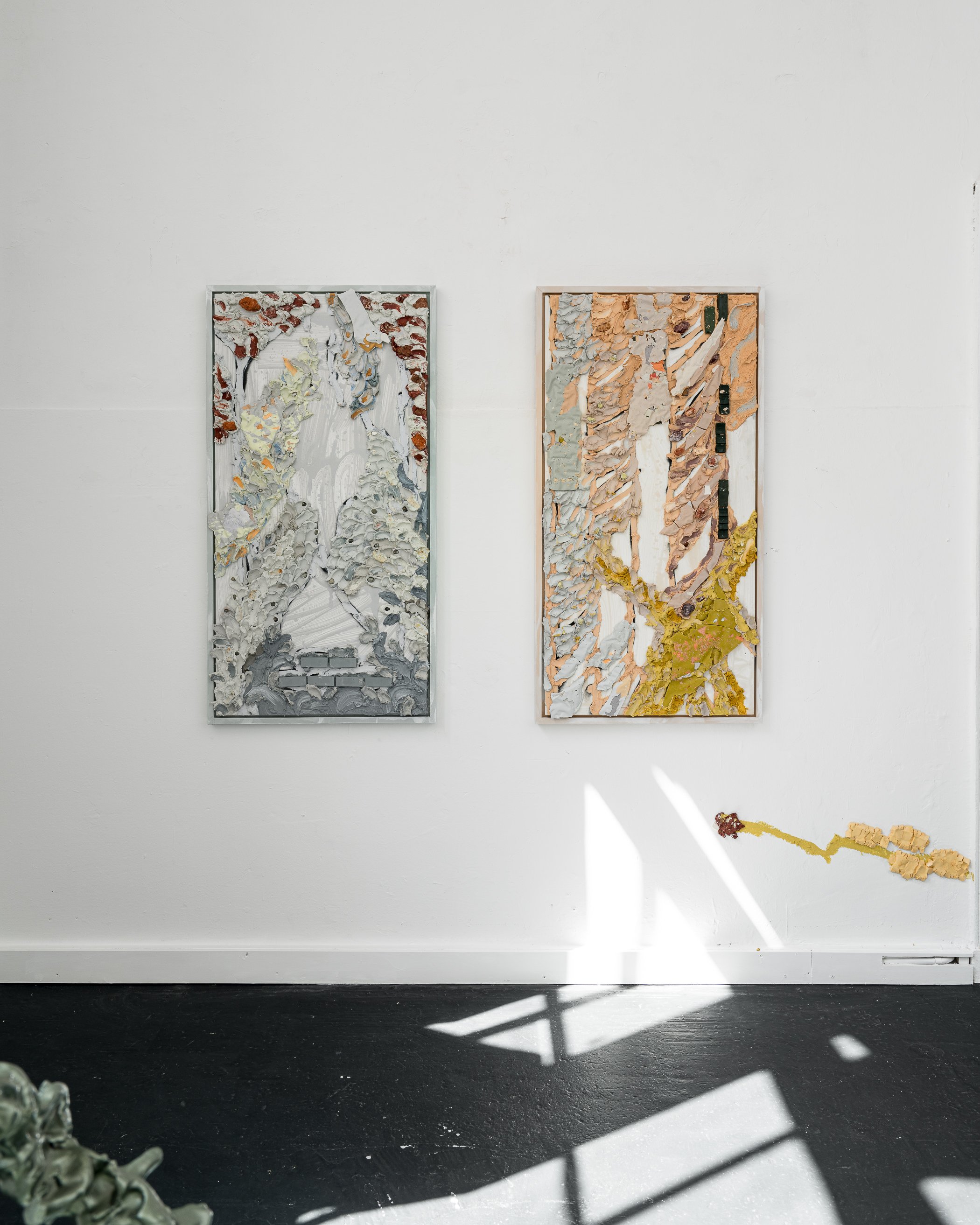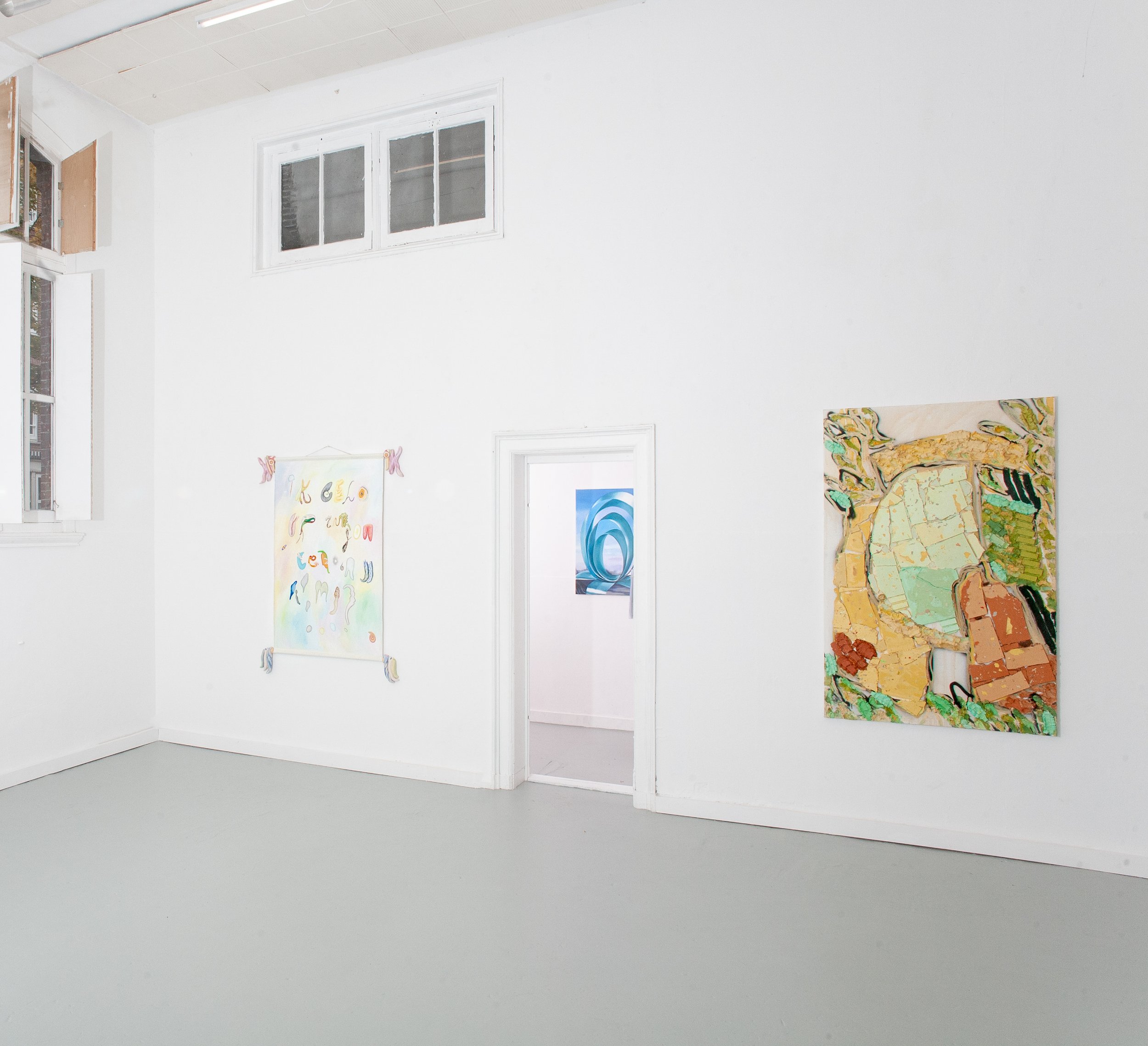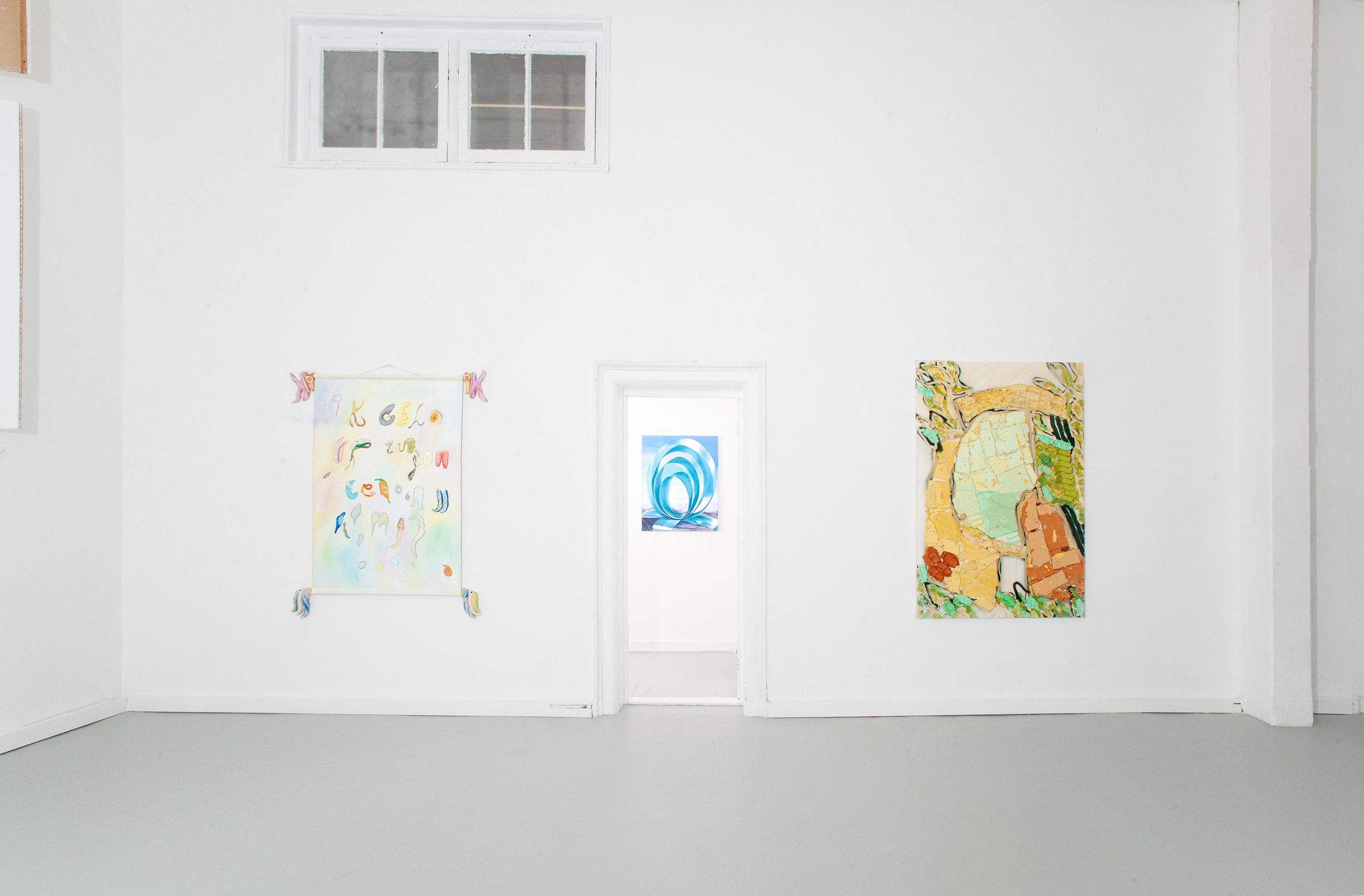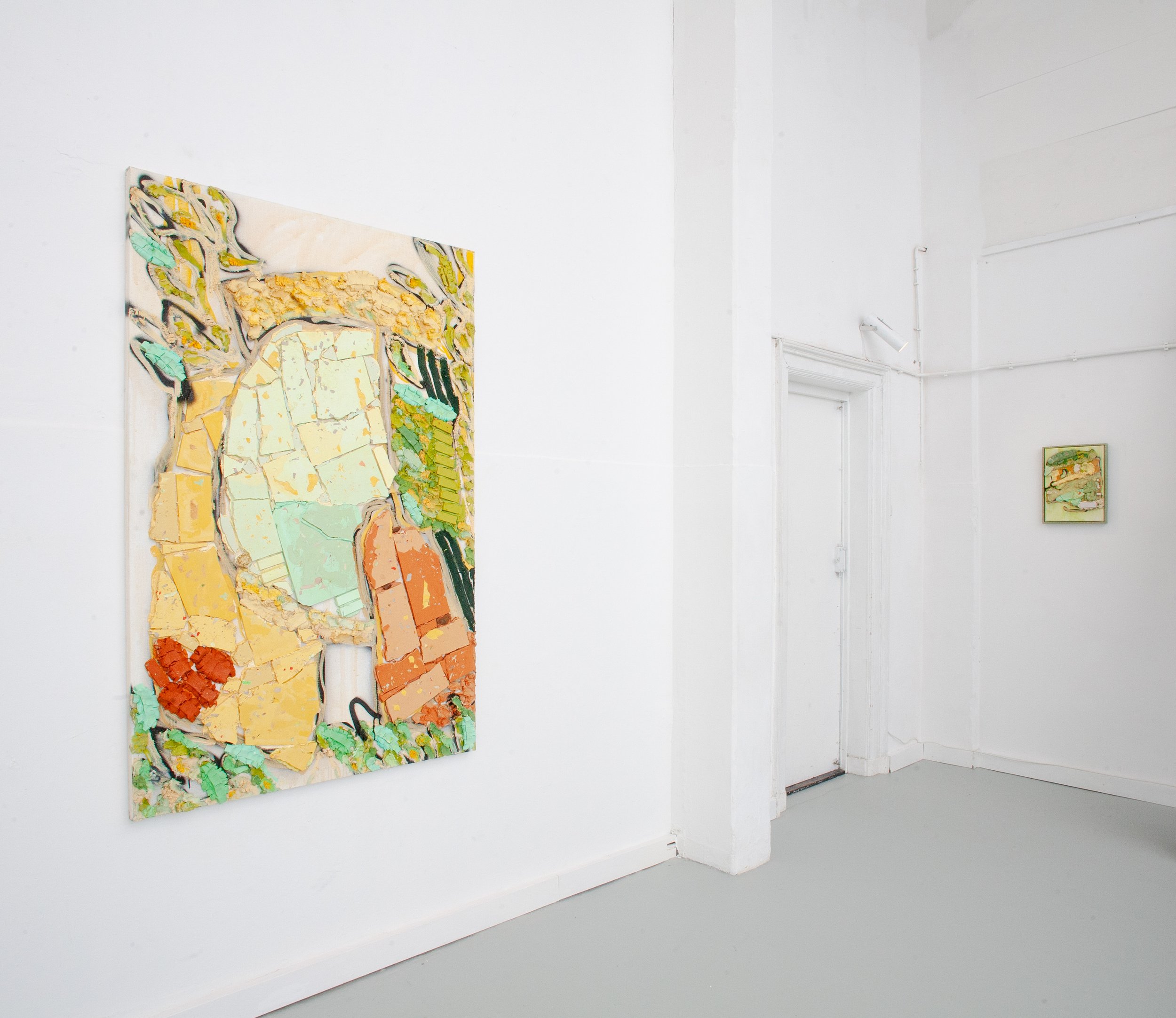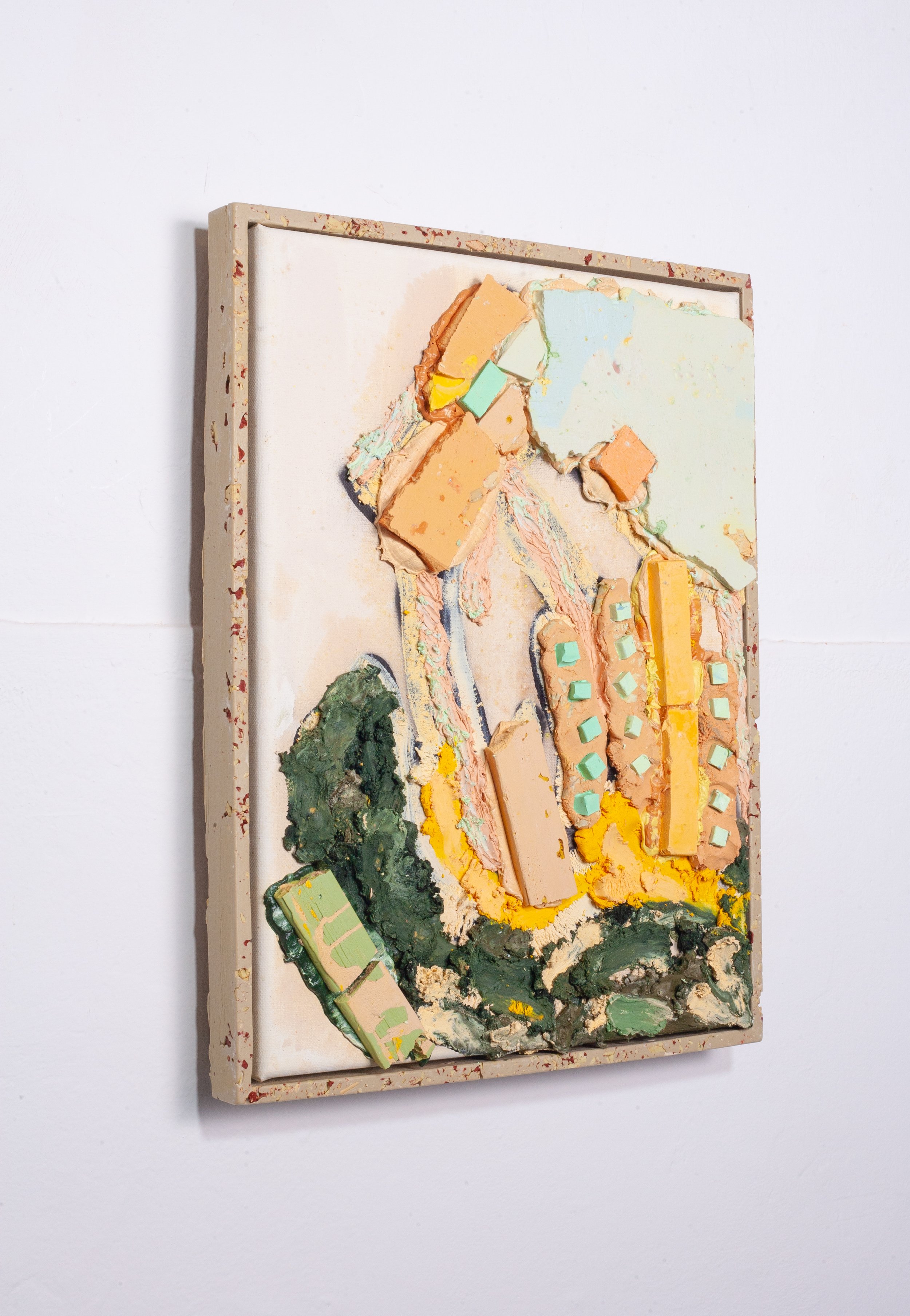
Natacha Mankowski
-
Natacha Mankowski -
Trained at the École Spéciale d’Architecture in Paris, Natacha Mankowski (Paris, FR, 1986) worked as an architect alongside Jean Nouvel and Vito Acconci before turning to painting. Her architectural background still resonates strongly in her paintings. Defying the boundaries between different artistic disciplines, Mankowski’s work is characterized by an exuberant use of the impasto technique. The way she employs this technique allows her to create textural and spatial structures in her paintings that moves them into the realm of sculpture. In her new work Natacha Mankowski has intensified this spatial and sculptural effect by working with larger formats. With many of these new paintings weighing 15 to 20 kilograms and more, they acquire a singular sense of gravity and presence; indeed, these paintings are objects that themselves inhabit a space alongside the viewers.
To address the question of how humans inhabit space at the intersection of nature and culture, Natacha Mankowski has developed her own visual and compositional language. While her compositions may seem abstract to the casual viewer, they are somewhat reminiscent of blueprints and ground maps widely used in architectural design and urban planning. This is no coincidence: many of her paintings are loosely inspired by the ground maps of the quarries she visited during her years as an architect.
Mankowski takes a keen interest in sites such as stone quarries, from which architects and builders collect their raw materials. Midway between nature and the built environment, quarries are transitional sites in which natural resources are excavated and turned into raw commodities to be used in buildings, but also cell phones, computers, and other modern technologies. So as much as we would like to believe we are far removed from nature, through these rough materials we are intrinsically connected to it. And as such, the mines and quarries where these materials are found also raise difficult questions about how humans have turned nature into a site for commodification, a process that has brought us high-tech and the urban environment but has also triggered ecological ruin and collapse.
Inspired by these issues, Mankowski has explored and visited many of these quarries, paying close attention to their geographical lay-out and the specific selection of raw materials on site. She then uses samples of these raw materials to create the thick impasto paint that texture her painterly work. (Words by Bram Ieven)
Natacha Mankowski has exhibited in numerous international exhibitions, such as: Zentrum fur Kunst ind Urbanistik (Berlin, GE) 2014 ; the Watermill Center (NY, USA) 2015, Pole muséal de Lisieux – Ateliers Intermédiaires (Lisieux, FR) 2015, Ceci Foundation (Berlin, GE) 2016, New Day Gallery (Berlin, GE) 2016, Souvenirs (Berlin, GE) 2016, the Epigraphic Museum (Athens, GR) 2018, Deschool and ISO (Amsterdam, NL), 2019, Centre d’Art Contemporain, Grenoble. She had several gallery shows at and is still working together with Everyday Gallery (2019 - 2022), Antwerp and Valerius Gallery (2022), Luxembourg City. She did a number of recidencies around the world and has been invited to teach at prestigious art schools like Sandberg Insitituut, Amsterdam. Mankowski is part of the Taylor Foundation in Paris and was the recipient of the Tony Garnier Prize, for Architecture and Urbanism awarded by the Académie Française d’Architecture in Paris.
-
-
Wow Amsterdam, Duologue with Natacha Mankowski
Emergent Magazine, Natacha Mankowski at Everyday Gallery
Luxembourg Times, Eye Catching Exhibition -
Paris, France, 1986, lives and works in Amsterdam
Education
2012 Habilitation à Maîtrise d’Oeuvre NP, École Spéciale d’Architecture, Paris, France
2011 MA in Architecture, École Spéciale d’Architecture, Paris, France
2009 University of Cincinnati - DAAP, Cincinnati, USA
2004 University Pierre et Marie Curie, Paris - La Sorbonne, Paris, France
Awards
2014 Fondation Taylor, Paris, France
2012 Tony Garnier Prize for Urbanism at the French Architectural Academy, Paris, France Collections Houthoff Municipality of Amsterdam
Exhibitions
2024
Enter Art Fair, Copenhagen, with Galerie Fleur & Wouter, solo
Arco Madrid, with Galeria Alegria, group
Ballroom Project, Antwerp, with Galerie Fleur & Wouter, solo
Art Rotterdam, Rotterdam, with Galerie Fleur & Wouter, group
2023
Houthoff, Mural at headquarters, Amsterdam Galerie Fleur & Wouter, Amsterdam, ‘Milos’, solo
ISO, Amsterdam, Open studio’s during Amsterdam Art Week Galeria Algeria, Barcelona, ‘Another Sun’, solo Huidenclub, Rotterdam, ‘Warmly’, group
Art Rotterdam, Rotterdam, with Valerius Gallery, duo
Valerius Gallery, Luxembourg, ‘Milos’, solo
De School, Amsterdam, ‘Sun-Day-Core’ duo (project supported by AFK)
2022
Galerie Fleur & Wouter, Amsterdam, ’Painter’s Painters’, group
Art Brussels, with Everyday Gallery, group
Amsterdam Art Week exhibition at Capital C, Amsterdam, with ISO
Valerius Gallery, Luxembourg, ‘Both Skies Open to Thunder’, duo
Centre d’Art Contemporain, Grenoble, ‘La position de l’amour’, group
Everyday Gallery, Antwerp, ‘Gado Gado’, group
Bad Bordeaux, Bordeaux, with Valerius Gallery, group
Art Rotterdam, Rotterdam, with Everyday Gallery, group
Le lac, Brussels, ‘Matière Primaire’, group
Dead Darlings, Berlin, auction, ‘From Stage-fright to Limelight’
2021
Everyday Gallery, Antwerp, ‘Soil is concrete’, solo
Art Rotterdam, with Everyday Gallery, Rotterdam, group
Everyday Gallery, Antwerp, ‘The Sun also rises’, group
Everyday Gallery, Antwerp, ‘Pot Luck’, group
2020
Everyday Gallery, Antwerp, ‘Limbo II’, group
De school, Amsterdam, ‘De Tour’, group
Online show for ISO, Amsterdam, curated by Kaspar De Jong, ‘Stay at home’, group
HVW8 Gallery, Berlin,’ Pause in your flight’, group
Art Rotterdam, Rotterdam, with Everyday Gallery, group
Collectible Fair, Brussels, with Everyday Gallery, group
2019
Everyday Gallery, Antwerp, ‘Nude’, group
De School, Amsterdam, ‘Dune’, duo
Playstation Sloterdijk, Amsterdam, Art Route, public artwork ‘Get Lost’, solo
2018
Epigraphic Museum of Athens, Athens, ‘Monument’, solo
Le Consulat de la Gaité, Paris, ‘Support-Surface’, duo
Bubenberg, Paris, ‘Morceaux Choisis II’, group
Villa Noailles, Hyères, ‘Design Parade III’, group
New Day Galerie, Berlin, group
2017
Corbusierhaus, Ceci Fondation, Berlin, ‘Space is non static’, solo
Bubenberg, Paris, ‘Morceaux Choisis I’, group
GlogauAir, Berlin, ‘The Voice of Doxa’, group
Fernseheturm, Berlin, Festival of lights
Novado Gallery, New Jersey, ‘B&W’, group
Berghain, Berlin, ‘Suno 2’, group
Biennale, St Etienne, ‘Working Promesse’
2016
New Day Gallery, Berlin, ‘In the zone’, solo
Ceci Foundation, Berlin, ‘The Waves’, group
The Hospital Gallery, Berlin, ‘Suno’, solo
Le coeur, Paris, ‘Only Lovers’, group
Sara Nightingale Gallery, Watermill, NY, USA, ‘Team Spirit’, group
Pôle muséal, Lisieux, ‘Trait’
2015
Watermill Center, New York, ‘The Island’
Konzulát, Berlin, ‘Zoo experiment’
Dublin, ‘Memory and Places, Describing Architecture’
Berghain, Berlin, ‘Turn around bright eyes’
2014
Ains Ah, Berlin, ‘Animal Space’, solo
Das Gift, Berlin, ‘Space Oddity’, solo
ZKU, Zentrum fur Kunst und Urbanistiks, Berlin, ‘White Hole’, solo
Konzulát, Berlin Art Week, Berlin, group
Kreuzberg Pavillion, Berlin, Same Standing - 166, group
ZKU Berlin, installation, Stadtumbau, ‘Flat Spaces’
MoP, Berlin, ‘I am an Oasis’, group
Residencies
2023 De School, Amsterdam (2 months)
2022 CNAC, Le Magasin, Grenoble, France (1 month)
2022 Sterna, Nisyros, Greece (1 month)
2020 De School, Amsterdam, The Netherlands (2 months)
2020 WOW, Amsterdam, The Netherlands (2 years)
2019 Palazzo Monti, Brescia, Italie (1 month)
2018 Le Consulat de la Gaité, Paris, France (2 months)
2018 Epigraphic Museum of Athens, Greece (1 month)
2017 Bundanon Trust, Sydney, Australia (2 weeks)
2016 ESKFF, Mana Contemporary, New Jersey, USA (3 months)
2015 Villa Lena, Tuscany, Italy (2 months)
2015 Watermill Center, New York, USA (1 month)
2015 Brooklyn Navy Yard, New York, USA (1 year)
2014 ZKU, Zentrum fur Kunst und Urbanistiks, Berlin, Germany (4 months)
2014 GlogauAir, Berlin, Germany (1 month)
Teaching
2016 Studio for Immediate Spaces, Dep. of Art and Architecture, Sandberg Institute, Amsterdam, NL
Publications and articles
2023 In Dust, Self-publication in collaboration with Valerius Gallery Beeldhouwen met verf, Kunstenaar Natacha Mankowski, Resident Magazine, NL
2022 The eco-conscious pastels of Natacha Mankowski, Walter van Teeffelen, If then is now,
2022 Eye-catching exhibition puts nature in the limelight, Gabriel Antar, Luxembourg Times https://www.luxtimes.lu/en/culture/eye-catching-exhibition-puts-nature-in-the-limelight-61f2b767de135b923679f5f6
2021 Soil is concrete, Publication in collaboration with Everyday Gallery, Design and Concept Frédérique Gagnon and Virginie Gauthier.
2021 https://artviewer.org/natacha-mankowski-at-everyday-gallery/
2021 https://www.emergentmag.com/exhibitions/natacha-mankowski-at-everyday-gallery
2020 Duologue with Natacha Mankowski https://www.wow amsterdam.nl/2020/12/natachamankowksi/
